SCIENCE IN FOCUS
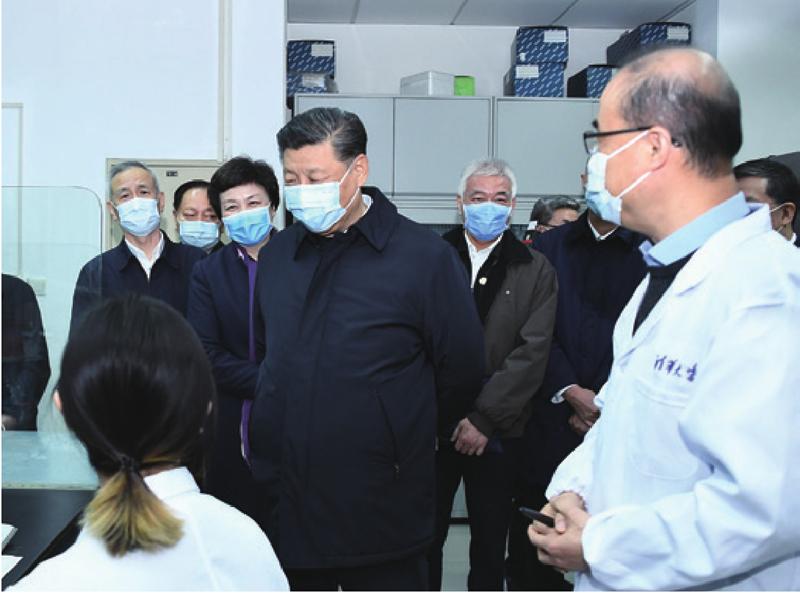
President Xi Jinping talks with researchers during his visit to the School of Medicine at Tsinghua University in Beijing on March 2.
Xi, also General Secretary of the Communist Party of China Central Committee and Chairman of the Central Military Commission, inspected the research work on the novel coronavirus disease as well as diagnosis and treatment that day.
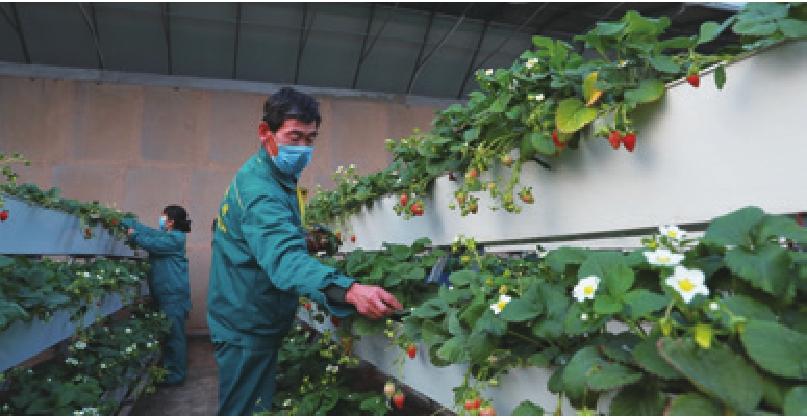
Modern Agriculture
A worker trims strawberry plants at a modern agriculture demonstration park in Lanzhou New Area, Gansu Province in northwest China, on March 3. Lanzhou New Area is using its geographical advantage and favorable local policies to develop its vegetable, fruit and fl ower planting industry.
Environment Guideline
A guideline to build a modern environmental governance system was issued on March 3 to provide institutional support for a better ecological environment.
Issued by the general offices of the Communist Party of China Central Committee and the State Council, it aims to put in place by 2025 a sound environmental governance system that specifies the responsibilities of governments at all levels and firms, encourages public participation and features stronger government supervision.
A greener approach to production will be promoted among fi rms, and innovative technologies strengthened to reduce pollutants. Businesses will have to disclose their pollutionrelated information and will be held responsible for its authenticity.
Financial support for environmental protection will be boosted and a fund established for green development.
New Professions
The human resources authority has given offi cial recognition to 16 new professions to keep pace with economic and technological development.
The new professions, mostly in the emerging industries and service sectors, include intelligent manufacturing technicians, virtual reality technicians, artifi cial intelligence trainers and all-media operators, according to a statement jointly issued by the Ministry of Human Resources and Social Security and other departments.
As the Chinese economy is shifting toward high-quality development, new jobs requiring new skills and knowledge have appeared in various industries.
The new jobs can boost the development of related industries, increase employment, and strengthen vocational education and training, the statement said.
This is the second time that new professions have been added to the occupation list since 2015 when China unveiled its latest edition of occupational classifi cations. The fi rst time was in April 2019 when 13 new professions were added.
Feathered Friends
Keeping a tryst of more than 30 years, over 40,000 migratory blackheaded gulls fl ew thousands of kilometers from far-off lands this winter to Kunming, capital of Yunnan Province in southwest China known as Spring City for its balmy weather.
The novel coronavirus epidemic that has emptied public places made this years reunion different. Dianchi Lake and other popular habitats for the birds in the city have been closed to the public since January 27 to contain the epidemic. The residents in these areas used to feed the feathered visitors.
So since January 27, the Kunming Municipal Bureau of Forestry and Grassland has organized staff to carry more than 1,000 kg of food daily to the gull habitats, feeding the birds twice a day to make sure they survive the winter.
With peoples love and care, the number of wintering black-headed gulls in Kunming has risen from hundreds in the 1980s to more than 40,000 in recent years.
Crime Control
Yunnan, which borders Myanmar, Laos and Viet Nam, has introduced a detailed plan to intensify its crackdown on wildlife crimes.
According to the Yunnan Provincial Forestry and Grassland Administration, technologies such as remote sensing, the Internet of Things and big data will be applied to build an integrated monitoring network to reduce smuggling, eating and imports of wild animals.
Wang Weibin, deputy head of the administration, said forestry authorities across the province are cracking down on poaching and illegal trading activities and will monitor nature reserves.
The plan also proposes regular and irregular joint border law enforcement operations and cross-border cooperation in infrastructure building, training and management.
Insight Into Virus
Chinese scientists have identified the mechanism of how the novel coronavirus infects humans, which could explain the molecular basis for coronavirus recognition and infection and provide a basis for the development of therapeutics.
The study published online in the journal Science on March 4 describes the structure of a human receptor at the surface of a cell that the novel coronavirus hijacks to enter a human.
Scientists from Westlake Institute for Advanced Study and Tsinghua University used the cryogenic electron microscopy to map, at atomic level, the full-length structure of angiotensinconverting enzyme 2, the entry point into human cells for the novel coronavirus, in the presence of a neutral amino acid transporter called B0AT1.
“Our f nidings not only shed light on the mechanistic understand-ing of viral infection, but will also facilitate development of viral detection techniques and potential antiviral therapeutics,” said the papers authors.
COVID-19 Research
Chinese researchers have found that novel coronavirus disease (COVID-19) patients may have no fever or CT abnormality, according to a study published in The New England Journal of Medicine recently.
On the whole, fever and cough were the most common symptoms while diarrhea was uncommon, said the article with renowned respiratory expert Zhong Nanshan as the corresponding author.
About 43.8 percent of the studied patients had a fever when they were admitted to hospital, and the rate rose to 88.7 percent during hospitalization as the disease got severe, it said.
The absence of fever in COVID-19 is more frequent than in severe acute respiratory syndrome and Middle East respiratory syndrome and the patients may be missed if the surveillance case defi nition focuses on fever detection, it said.
The study elaborated on the clinical characteristics of COVID-19 infection based on the data of 1,099 laboratory-confi rmed patients from 552 hospitals in 30 provinces, autonomous regions and municipalities across China.
On admission, about 56.4 percent of the patients were found with ground-glass opacity on chest computed tomography.
But no radiographic or CT abnormality was found in 157 of 877 patients(17.9 percent) with non-severe disease and in fi ve of 173 patients (2.9 percent) with severe disease.

Online Opera
Yuju Opera performer Li Jinling livestreams a performance at the Zhengzhou Cultural Center in Zhengzhou, Henan Province in central China, on March 3. The center has launched an online platform to offer performances to the public during the period of epidemic control.
Religious Diversity
Various religions have been coexisting in harmony in China, a senior Chinese diplomat said on March 2 during the 43rd session of the United Nations (UN) Human Rights Council in Geneva.
This not only demonstrates the spirit of compatibility and tolerance in traditional Chinese culture, but also shows that the religious policy adopted by the Chinese Government is in line with Chinas national conditions, Liu Hua, special representative for human rights affairs, said.
During a dialogue with the UN special rapporteur on freedom of religion or belief, she said Chinas Constitution stipulates that no state organ, public organization or individual may compel citizens to believe in, or not to believe in, any religion, nor may they discriminate against citizens who believe in, or do not believe in, any religion.
According to her, China is now home to many religions. There are more than 5,500 religious groups, nearly 100 religious colleges and about 140,000 places for religious activities in China.
Corporate Aids
Companies based in Zhejiang Province in east China are donating epidemic prevention materials to help other countries fi ght against the novel coronavirus.
The Jack Ma Foundation and Alibaba Foundation announced on March 2 that they will collect and donate 1 million masks to Japan.
Jack Ma, the founder of ecommerce giant Alibaba Group, said on Twitter-like Weibo that Japanese friends reached out when China was in great shortage. Its time to return that favor.
In February, various circles in Japan collected and donated 125,000 protective suits to cities across China.
Wenzhou in Zhejiang is home to hundreds of thousands of overseas Chinese. An online donation was initiated by the citys entrepreneurs and youth to raise funds for the coronavirus fi ght in Italy.
On March 1, 2,600 pairs of protective goggles worth 200,000 yuan($28,690), produced by local companies and donated by the glasses trade association in Wenzhou, were loaded on a plane to Turin in Italy.
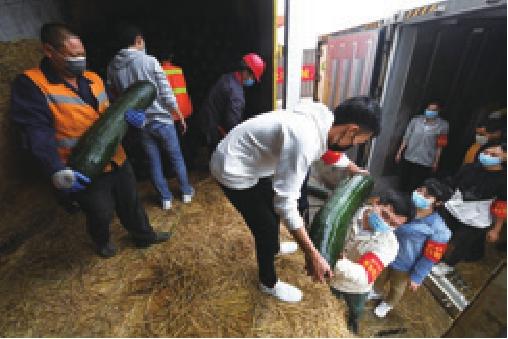
Giving a Hand
At the Nanning International Railway Port in Nanning, capital of Guangxi Zhuang Autonomous Region in south China, staff load materials to support Hubei, the province hit hardest by the novel coronavirus outbreak, on March 3. As of March 3, Guangxi had transported over 3,000 tons of materials to Hubei.
Investment Steps
Shanghai unveiled a number of new measures on March 1 to facilitate the development of foreigninvested enterprises, as part of its efforts to further open up and spur growth, and minimize the impact of the novel coronavirus outbreak.
The city aims to build up foreign investors confi dence in longterm investment and operation by easing market access, Hua Yuan, Director of the municipal commission of commerce, said during a teleconference.
“We will strive to expand opening up in key sectors including telecommunication, insurance, securities, research and technical services, education and health services,” Hua said.
He urged more support for attracting foreign investment, especially in high value-added modern service industries such as advanced manufacturing, science and technology services as well as information services.
Shanghai is expected to see 40 more regional headquarters of multinationals and 15 more foreign-funded research and development centers this year, according to him.
Teleworking modes such as video conferences and online contracts should be promoted to strengthen communication with foreign investors, he added.
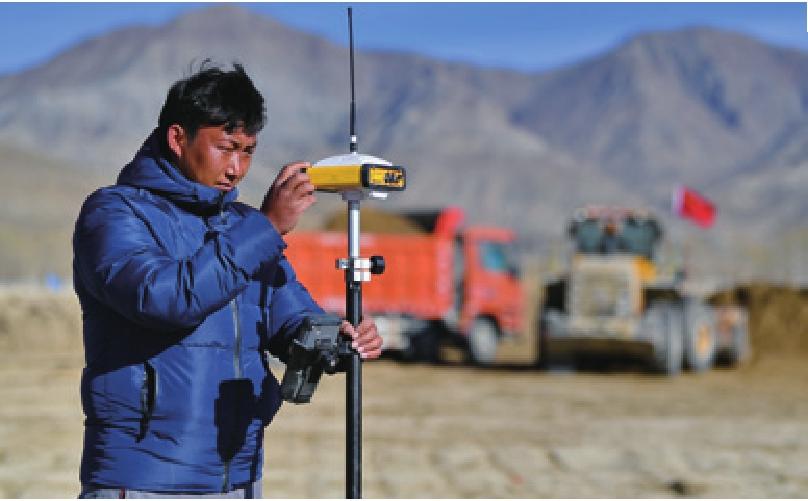
Looking Ahead to a Better Future
A staffer conducts a survey at the construction site of a high-standard farmland in Natang Village in Xigaze, Tibet Autonomous Region in southwest China, on March 1. The local government is promoting the construction of high-standard farmland by leveling and connecting scattered lands and building irrigation facilities.
Foreign Trade
Chinas foreign trade is capable of weathering the novel coronavirus outbreak and will see progress once the epidemic is contained, experts said.
“Though Chinas foreign trade sector is facing a big test, it can deliver satisfactory results,” Wei Jianguo, Vice Chairman of the China Center for International Economic Exchanges (CCIEE), told a news conference on February 28.
Wei estimated that exports would slide in the fi rst three months of the year but rebound in the second quarter, while imports will notch double-digit year-onyear growth in 2020.
Private fi rms are now major contributors to Chinas foreign trade, and are more sensitive and open to market changes compared to the 2003 SARS epidemic period, Wei said. He cited Yiwu International Trade Market in the eastern province of Zhejiang as an example, noting that businesses there have restarted operation recently after detecting market demand.
Wei predicted imports would rise rapidly in the wake of the outbreak as it has not dampened consumer demand and there is huge development potential in the healthcare, travel, culture and training sectors.
Noting that the impact of the outbreak might ripple around the world and disrupt the global supply chain, Wei advised China, Japan and the Republic of Korea to strengthen industrial cooperation to minimize uncertainties.
“The outbreak is confi ned to certain areas and is temporary, but the cooperation on supply chain is long-term and based on strategic considerations,” said Zhang Yansheng, chief researcher with the CCIEE.
With the emergence of new technologies such as artifi cial intelligence and 5G, the collaboration on supply chain will evolve and become more fl exible, according to Zhang. “Since China has experienced transformations amid economic slowdown, I believe this epidemic can also bring opportunities,” he said.
Aviation Industry
The civil aviation sector has stepped up support for the fi ght against the novel coronavirus, according to the Civil Aviation Administration of China (CAAC).
The sector had transported 26,375 tons of supplies for epidemic prevention and control via 19,344 fl ights by February 29, data from CAAC showed.
A total of 7,151 tons of emergency materials had been sent to Hubei Province via 584 fl ights and civil airlines had brought more than 1,300 Hubei tourists stranded overseas back to China by February 29, CAAC said.
Flights between China and Japan, and China and the Republic of Korea have been reduced since the virus spread in the two countries.
The aviation industry is pay-ing special attention to epidemic prevention and control and the health of operational staff as well as increasing the frequency of aircraft cleaning and disinfection.
Coal Production
Guizhou Province in the southwest plans to phase out 10 million tons of outdated coal production capacity by closing 80 coal mines in 2020.
In recent years, the coal-rich province has been promoting the transformation and upgrading of its coal industry by closing small and outdated mines and using more smart machinery, the provincial energy bureau said.
Local authorities have ordered the closure of small coal mines with an annual production capacity of less than 300,000 tons as well as larger mines whose production or construction has long been suspended.
The bureau also called for beefi ng up the utilization of coalbed methane to improve coal mine work safety and increase power generation from green energy.
In recent years, China has been phasing out outdated production capacity in a wide range of sectors, including coal and steel, amid efforts to promote high-quality economic growth.
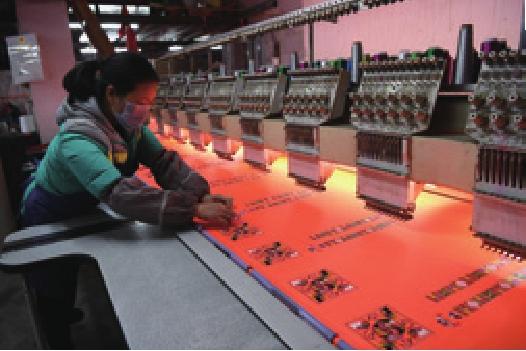
Weaving Opportunities
Workers make embroidery products in a factory in Rongjiang County, Guizhou Province in southwest China, on March 2. The county has increased support for the local embroidery industry and is encouraging enterprises to adopt hi-tech facilities to inject new impetus into the traditional craftsmanship.
Railway Projects
The National Development and Reform Commission (NDRC), Chinas top economic planner, has pledged more efforts to promote railway construction, stressing progress of key projects.
Efforts will be made to speed up the construction of major projects including the SichuanTibet Railway and the high-speed railway along the Yangtze River, according to a statement released by the NDRC on March 3.
Railway construction in central and western regions of the country will be strengthened and the inter-city rail projects will be advanced in an orderly manner, it said.
The commission highlighted the equal importance of passenger and cargo rail transport.
Chinas railway network had reached 139,000 km by the end of last year, with 35,000 km of highspeed railways. The country plans to expand the railway network by more than 4,000 km in 2020.
Machinery Growth
Chinas machinery industry is expected to see a mild growth in revenues and profi ts this year if the novel coronavirus outbreak ends at an early date, the China Machinery Industry Federation said at an online press conference on February 25.
Shortages of workers and anti-epidemic products, as well as transport and supply chain disruptions, will constrain the growth of the machinery industry in the short term, possibly leading to a substantial decline in the industrys major economic indicators for the fi rst quarter.
However, thanks to a slew of supportive measures, market confi dence will rebound in the medium term. If the epidemic is contained effectively in the fi rst quarter, over 90 percent of machinery companies will return to full operation in the second quarter.
From a long-term perspective, Chinas economic fundamentals remain stable, and the country will ramp up construction and investment after the end of the epidemic, thus creating new opportunities for machinery companies.
With the performance of the machinery sector likely to pick up, a 5-percent growth in industrial output for the whole year is still achievable, it said.
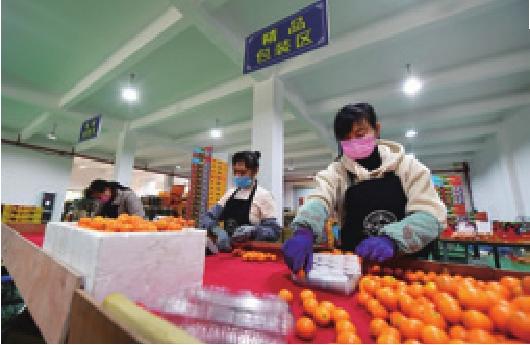
E-Commerce Channels
Workers pack kumquats at an e-commerce company in Rongan County, Guangxi Zhuang Autonomous Region in south China, on March 1. Since the outbreak of the novel coronavirus has made it diffi cult to sell kumquats, local authorities have encouraged around 100 local e-commerce companies to help farmers sell the fruit online.

